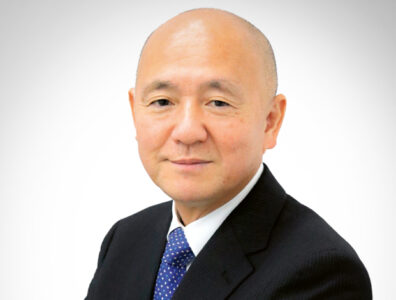
Pipe manufacturing for the UAE’s sour gasfields

Mitsuru Anezaki, CEO of Al Gharbia Pipe Company (AGPC), talks to The Energy Year about the company’s current projects and the competitive advantages that have allowed it to supply high-profile projects. AGPC manufactures LSAW steel pipes at the UAE’s first large-diameter, sour-service-capable steel pipe production facility at Khalifa Economic Zone Abu Dhabi.
What main projects is AGPC working on?
We started operations back in 2019 as a joint venture between ADQ, JFE Steel, and Marubeni Itochu Steel with a USD 200-million capex investment to develop 18- to 56-inch pipe manufacturing capabilities in the country. It was challenging to start operations during the Covid pandemic, but with the ambitions laid out by ADNOC and the current uptrend in the market, we have reached 70,000 tonnes of production this year.
Currently we are engaged in work for a mega-project developed by ADNOC Gas that aims to create a 300-kilometre network of gas pipelines from Abu Dhabi through the Emirates. We are also working on ADNOC’s Project Wave, which will supply seawater through 100 kilometres of pipelines to oilfields to use for enhanced recovery techniques and to stabilise production rates.
There is also a pipeline planned between Abu Dhabi and Fujairah to supply LNG to a plant currently under construction. For NPCC we will produce in May and August more than 33,000 tonnes of pipeline for the Lower Zakum sour gas project, which has stringent specifications.
What are the specificities of the market you have to adapt to?
There are different types of pipe requirements depending on the end use. Offshore pipelines do not need a large diameter, typically requiring 24-30 inches, as is the case for Lower Zakum. However, onshore pipes, especially for sour gas, require larger diameters to resist the high pressures needed to transport the gas and usually use pipes larger than 40 inches.
Seamless drilling pipes, typically used as OCTG [oil country tubular goods], are required for high temperatures and pressure. Threaded connections are also needed on both ends of the pipe, whereas pipelines are normally welded.
For oil and gas transportation, we usually work with LSAW pipe types, which respond to the quality requirements specified by ADNOC. For these we require specific plates, which we can typically procure from Europe, Japan or South Korea.
This constraint represents a main bottleneck for our activities. Sourcing raw materials from Europe is becoming increasingly difficult as many suppliers work to procure for offshore wind structural steel demand. In addition, the war in Ukraine has led to gas shortages, further impacting the supply of plates.
What competitive advantages have given AGPC the capability to supply high-profile projects?
Our partner JFE Steel is a world-leading pipe manufacturing company from Hiroshima that has developed expertise over the past half-century. Some of our engineers, including our CTO [chief technical officer] were working there beforehand, thus allowing for a great transfer of technology and experience.
Furthermore, we have a contract with a German company called SMS, a leading global steel equipment company that has helped develop a state-of-the-art plant. This combination, along with our human resource capabilities, makes this facility one of the most advanced pipe-producing plants worldwide.
Furthermore, what makes us strong is also the ISO 17025-certified laboratory facilities we use for testing with hydrogen-induced cracking methods, which is crucial to verify the resistance of the steel in certain environments.
We are also looking to integrate Industry 4.0 technologies in our operations such as AI and smart manufacturing techniques that further automation and optimisation through the production process. We use a machine learning algorithm on our press that variates the pressure and power based on the material it is working on.
Lastly, we have a very high ICV score as 100% of our investment is within the UAE and helps the promotion of the “Made in the UAE” dynamic. Since our inception, we have landed more than 90% of the projects we’ve tendered for and have produced around 610 kilometres of pipeline.
What ambitions and expectations do you have laid out for the coming year?
Our business is project based and thus is affected by the volatility of the market, which is why our current utilisation rate is around 60%. In 2023, however, we will see a great boost and expect to achieve around 90% of our targeted 240,000-tonne-per-year capacity.
Our main focus will remain on the opportunities that develop along with ADNOC’s plans. We are looking forward to participating in further mega-projects and also look to penetrate new markets. Along with our partner JFE Steel, we are scouting the opportunities to enter the hydrogen sector and have completed initial trials for plates.
One area of interest is the country’s carbon capture ambitions through CCS and CCUS. Already, 700,000 tonnes of CO2 per year are captured and utilised for enhanced oil recovery in the UAE, a figure that is expected to increase to 5 million by 2030.
Lastly, we are looking towards export opportunities in Qatar, Iraq and Saudi Arabia.
Read our latest insights on:




















